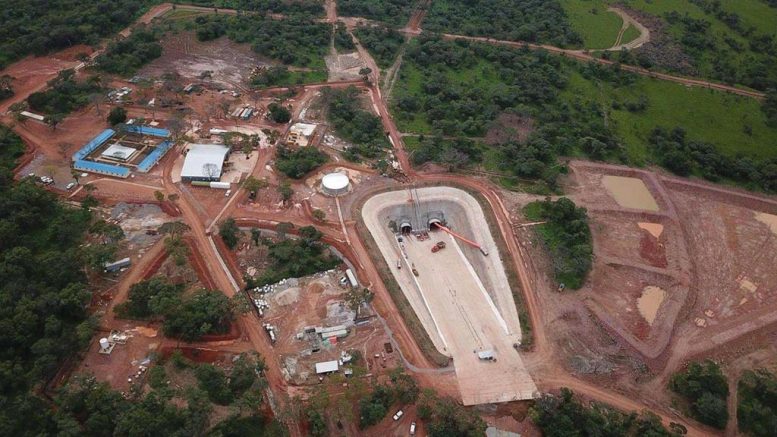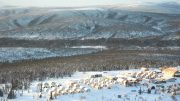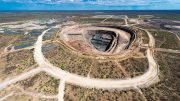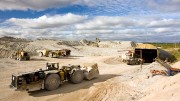The Northern Miner has compiled a list of the top-10 base metal and uranium juniors — with no production, and which are not a royalty company — headquartered in Canada, arranged by market capitalization as of early July.
1. IVANHOE MINES
$4.5B market cap
Robert Friedland’s Ivanhoe Mines (TSX: IVN; US-OTC: IVPAF) sits atop the top-10 list for the third year in a row, and up $2.5 billion in market capitalization to $4.5 billion in early July 2019.
The company is developing three world-class projects in sub-Saharan Africa: the Kamoa–Kakula copper project in the Democratic Republic of the Congo (DRC), where Ivanhoe has a 39.6% stake, equal with partner Zijin Mining; the Platreef project in South Africa, for platinum group metals and nickel (64% stake); and the Kipushi zinc project, also in the DRC (68% stake).
Kamoa–Kakula ranks as one of the world’s highest-copper discoveries in recent decades, and comes in the form of a near-surface, flat-lying, stratiform copper deposit, 25 km west of the town of Kolwezi.
Kamoa–Kakula boasts a combined indicated resource of 1.39 billion indicated tonnes grading 2.64% copper for 36.6 million tonnes (80.6 billion lb.) contained copper, plus 316 million inferred tonnes at 1.76% copper for 5.6 million tonnes contained copper.
2. NEXGEN ENERGY
$743M market cap

NexGen Energy’s uranium exploration camp in northern Saskatchewan’s Athabasca basin. Credit: NexGen Energy.
With Arizona Mining dropping off the list after last year’s $1.8-billion takeover by South32, Vancouver-based uranium explorer NexGen Energy (TSX: NXE; NYSE-AM: NXE) moves up to second spot among base metal and uranium developers.
NexGen has emerged as the biggest winner so far coming out of uranium exploration in the underexplored southwestern part of Saskatchewan’s Athabasca basin, In 2018 the company won the Prospectors & Developers Association of Canada’s Bill Dennis Award for a Canadian discovery.
As of 2018, the various structures at Arrow host a combined 2.89 million indicated tonnes grading 4.03% uranium oxide for 257 million lb. uranium oxide, plus 4.84 million inferred tonnes at 0.86% uranium oxide for 91.7 million lb. uranium oxide.
A recent prefeasibility shows the project capable of producing 25.4 million lb. uranium oxide annually for nine years, which would turn NexGen into the world’s second-largest uranium miner, after Kazatomprom.
Former Saskatchewan premier Brad Wall is a NexGen director.
3. TRILOGY METALS
$526M market cap

Rick Van Nieuwenhuyse, president and CEO of Vancouver-based Trilogy Metals, at the company’s Arctic polymetallic project in Alaska’s Ambler district. Credit: Trilogy Metals.
Vancouver-based, Rick Van Nieuwenhuyse-led Trilogy Metals (TSX: TMQ; NYSE-AM: TMQ) has more than doubled its market capitalization, and risen from seventh to third spot on the list over the past year.
Trilogy is exploring its sizeable and high-grade Bornite copper-cobalt and Arctic polymetallic projects that are part of its Upper Kobuk mineral projects in Alaska’s Ambler mining district.
Work at Bornite is being funded by South32 under a joint venture, whereby South32 will spend US$150 million over three years to earn a 50% interest in the junior’s Alaskan assets.
The exploration program at Bornite started in June, with more than 2,000 metres drilled as of a July 9 update.
At the Arctic project, feasibility level studies are underway, with the goal of completing a feasibility study in the first half of 2020.
DENISON MINES
$394M market cap

David Cates, president and CEO of uranium developer Denison Mines. Credit: Erik Rotter for George Matthew Photography for The Northern Miner.
A member of the Lundin Group of Companies and led by David Cates, Denison Mines (TSX: DML; NYSE-AM: DNN) is a Toronto-based senior developer focused on exploration and development of uranium assets in Saskatchewan’s Athabasca basin.
Denison says its 90%-owned Wheeler River “ranks as the largest, undeveloped, high-grade uranium project in the infrastructure-rich eastern portion of the Athabasca basin.”
In June, Denison launched a program of in-situ recovery field testing at Wheeler River, as part of mid-year field work at the project.
The firm’s exploration portfolio in the basin consists of numerous projects covering 3,200 sq. km.
Denison is also engaged in mine decommissioning and environmental services through its Denison Environmental Services division, and manages Uranium Participation Corp. — a publicly traded company that invests in uranium oxide and uranium hexafluoride.
5. NGEX RESOURCES
$270M market cap

Taking in the view of NGEx Resources’ Josemaria copper-gold property in San Juan province, Argentina. Credit: NGEx Resources.
NGEx Resources (TSX: NGQ; US-OTC: NGQRF) — another member of the Lundin Group of Companies — is developing its two large copper-gold-silver discoveries, Los Helados and Josemaria, located in Chile’s Region III and adjacent San Juan Province, Argentina.
NGEX owns 100% of Josemaria and is majority partner and operator for Los Helados.
The junior says the assets are “considered one of the best exploration-development plays in the region.”
6. NORTHERN DYNASTY MINERALS
$259M market cap

Northern Dynasty Minerals’ Pebble copper-gold deposit, 321 km southwest of Anchorage, Alaska. Credit: Northern Dynasty Minerals.
Northern Dynasty Minerals’ (TSX: NDM; NYSE-AM: NAK) colossal Pebble copper-gold deposit in Alaska is too large to ignore, despite the vigorous and sustained opposition to its development from environmental groups.
Over the years, the asset has attracted a couple of major partners, who eventually walked away. The election of a pro-mining president in the U.S. in 2016 brought in optimism among Northern Dynasty Minerals shareholders that the project could regain positive momentum.
Resources at Pebble stand at 6.5 billion measured and indicated tonnes containing 57 billion lb. copper, 71 million oz. gold, 3.4 billion lb. molybdenum and 345 million oz. silver. Another 4.5 billion tonnes lie in the inferred category, containing 25 billion lb. copper, 36 million oz. gold, 2.2 billion lb. molybdenum and 170 million oz. silver. Palladium and rhenium are also present.
7. FISSION URANIUM
$233M market cap

Drillers at Fission Uranium’s Patterson Lake South uranium project in Saskatchewan. Photo by Richard Quarisa.
The third Athabasca basin trailblazer on the list is Kelowna, B.C.-based Fission Uranium (TSX: FCU; US-OTC: FCUUF), which is advancing its PLS uranium project, hosting the near-surface, high-grade Triple R deposit. Major high-grade zones have been found each year since its discovery in 2012, and Fission says exploration drilling has uncovered more mineralization west of the trend.
8. NEVADA COPPER
$218M market cap

The Pumpkin Hollow copper project, under construction in Nevada. Credit: Nevada Copper.
Vancouver-based Nevada Copper (TSX: NCU; US-OTC: NEVDF) calls its flagship Pumpkin Hollow copper-gold-silver project in Yerington, Nev., the “only major, shovel-ready and fully permitted copper project in North America.”
Its two fully permitted projects at Pumpkin Hollow include a high-grade underground mine — which is moving into construction, with first production in late 2019 — and an open-pit concept, undergoing optimization to look at a lower-capex, staged development.
Says Nevada Copper in a July 9 update: “It’s summer, but there’s certainly no slowing down here at Pumpkin Hollow! We are working hard below and above ground, and remain on track to enter production in the fourth quarter of this year.”
9. POLYMET MINING
$213M market cap

The historic Erie taconite processing plant, which Polymet Mining plans to refurbish for processing ore from its nearby Northmet polymetallic project in Minnesota. Credit: Polymet Mining.
Toronto-based Polymet Mining (TSX: POM; NYSE-AM: PLM) is focused on developing and bringing into production its NorthMet copper-nickel-precious metals project in northeastern Minnesota’s Mesabi Iron Range, where it also has its Erie Plant — a processing facility 10 km from the orebody that can be repurposed to handle NorthMet ore.
In June, PolyMet raised US$265 million in a fully subscribed rights offering. After the raise, Glencore boosted its ownership to 71.6% of PolyMet’s shares (69% fully diluted), with the mining titan buying 627 million shares in the rights offering.
PolyMet says the proceeds of the rights offering were used to repay a debt to Glencore “under certain debentures, and to pay the standby fee owed to Glencore, and the expenses of the rights offering.”
10. FILO MINING
$201M market cap

Outcropping mineralization at Filo Mining’s Filo del Sol copper-gold-silver property in Chile. Credit: Filo Mining.

Drillers at Filo Mining’s Filo del Sol copper-gold project in the Atacama region of Chile and Argentina. Credit: Filo Mining.
Filo Mining (TSXV: FIL) is the third and final Lundin Group company on list. It is developing its wholly owned Filo del Sol copper-gold-silver project, 140 km southeast of Copiapo, on the Chile–Argentina border.
Filo Mining was spun out of NGEx Resources in mid-2016 to evaluate the project’s potential for a low-cost, heap-leach operation, which resulted in a new resource estimate in July 2017, and a positive preliminary assessment in November 2017.
Indicated resources are 372 million tonnes of 0.34% copper, 0.33 gram gold and 9.2 grams silver per tonne, with another 239 million tonnes in the inferred category at slightly lower grades.
Recent drilling by Filo at the project cut 378 metres (from 134 metres) grading 0.44% copper, 89 gram gold per tonne and 42.5 grams silver per tonne.






Be the first to comment on "Top-10 base metals, uranium explorers and developers in Canada"